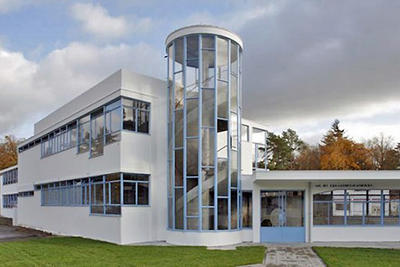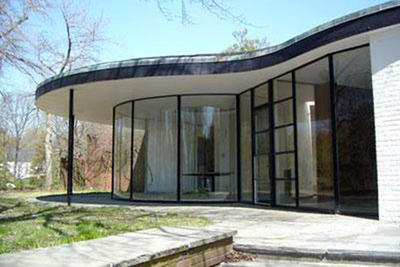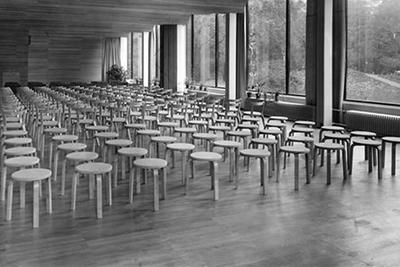Ensuring a future for great architecture from the less-distant past
Today’s built environment seems to evolve at an ever-increasing pace, as buildings appear and disappear from the horizon in decades rather than centuries. No longer is it a given that a noteworthy building will stand the test of time, and significant works of recent architecture are vulnerable to demolition before their value is widely appreciated.
Modernism is the defining movement in twentieth-century architecture. Yet many important modern structures are at risk, endangered due to neglect, inappropriate renovation, physical deterioration, and the threat of demolition. The innovative and experimental design elements, materials, and technologies that define these structures are often the biggest challenges to their preservation.
Time runs out for acclaimed modern schools
The fate of Riverview High School supports the need for vigilance. Designed by acclaimed architect Paul Rudolph, in Sarasota, Florida, Riverview first welcomed students in 1958. Rudolph’s design made the most of the local subtropical climate—in demand today as “green” building features—incorporating passive ventilation, day lighting, and shading. In its later years, however, unsympathetic alterations diminished its architectural appeal and weakened its environmental qualities, and the School Board of Sarasota County announced plans to demolish it, to be replaced with a parking lot.
In response, WMF included Riverview High School on the 2008 World Monuments Watch, and with the support of Knoll, launched an international competition for an adaptive reuse plan that would have turned the modern gem into an arts center. A vigorous campaign to save the school attracted a great deal of attention but ultimately was unsuccessful, as Riverview High School succumbed to the wrecking ball in 2009.
Two years later, Phillis Wheatley Elementary School in New Orleans suffered a similar fate.
Hovering above the vernacular Creole and Victorian houses of the Tremé/Lafitte neighborhood, the 1954 glass and steel structure offered a striking contrast in a city most noted for its eighteenth- and nineteenth-century architecture. Designed by architect Charles Colbert, the elevated cantilevered design was widely acclaimed and exhibited internationally.
More than 50 years later, the school survived the floods of Hurricane Katrina, but the disrepair and vandalism that followed took a toll. The threat of demolition loomed, and WMF included Phillis Wheatley on the 2010 World Monuments Watch to help rally support. Adaptive reuse plans were proposed, and residents, alumni, and architecture enthusiasts called for its survival, but opposing forces prevailed and the school was demolished in June 2011, offering another stark reminder of the increasing fragility of our modern architectural heritage.
Partner with WMF and take a stand for modern architecture
Your gift to WMF’s Modernism at Risk initiative will support the development of solutions for threatened modern buildings that are as innovative as the original designs were revolutionary.
World Monuments Fund's Modernism at Risk program has been made possible, in part, by support from Knoll and the David Davies and Jack Weeden Fund.
Modernism at Risk Dispatches

World Monuments Fund/Knoll Modernism Prize
WMF awards the World Monuments Fund/Knoll Modernism Prize biennially to a design professional or firm in recognition of an innovative architectural or design solution that preserves or enhances a modern landmark or landmarks.

In the Nick of Time
The bulldozer was on site and a permit had been issued to raze one of New York’s modern masterpieces at the time the A. Conger Goodyear House was included on the 2002 World Monuments Watch. With an impeccable pedigree that only magnified the potential loss, the house was designed and completed in 1938 by Edward Durell Stone, one of the country’s leading modern architects.

5 Case Studies: Modernism at Risk
The five case studies presented in our exhibition Modernism at Risk: Modern Solutions for Saving Modern Landmarks and this accompanying publication demonstrate multifaceted solutions—including advocacy efforts and technical plans—and address the distinct challenges to preserving modern architecture.

2014 World Monuments Fund/Knoll Modernism Prize: Viipuri Library
WMF awarded the 2014 World Monuments Fund/Knoll Modernism Prize to the Finnish Committee for the Restoration of Viipuri Library, with the Central City Alvar Aalto Library, for the restoration of Viipuri Library in Vyborg, the Russian Federation.

Current Project
George Nakashima’s 1960-75 studio, house, and workshop in Pennsylvania reflect his distinct style—mixing modern influences with Japanese craft traditions. A 2014 World Monuments Watch site, his home and studio are now a tribute to this master of modern design and craft. WMF has created an integrated conservation management plan for the site, including apprentice training, ensuring that Nakashima’s gifts are passed to future generations.

Founding Sponsor: Knoll
WMF thanks Knoll for their leading role in the preservation of modern architecture. As the founding sponsor of Modernism at Risk, Knoll makes it possible for WMF to develop solutions for threatened modern sites around the globe, and supports our work to bring international recognition to the importance of preserving modern landmarks through the World Monuments Fund/Knoll Modernism Prize.
Stay Informed
Interested in learning more about our work to preserve modern architecture? Sign up to receive occasional updates in your inbox.
